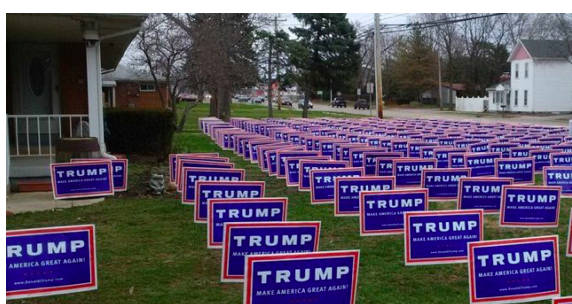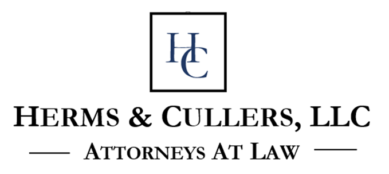With election season upon us, I am sure that many of us have witnessed the proliferation of political messaging, including yard signs in front of homes. Some folks get a little carried away, like this homeowner during the 2016 election:

You may ask: is it legal to place a hundred “Trump” signs in your front yard? How about a 10×20-foot banner? A more precise question would be: what can you do without risking legal consequences, such as a citation by the city or a nasty letter from your HOA?
There are three sources of law that may apply to temporary political signage on residential property. The first would be local ordinances, i.e., county or city codes. Municipalities generally have the power to regulate signage in the name of public health and safety as long as the regulations are content-neutral. I live in Larimer County, Colorado and we can take that as an example. The County code does not specifically address temporary or political signs. It considers poltical signs to be “ideological signs,” a category that includes religious messages. You can display any number of ideological signs on residential property without a permit as long as they do not sum to more than 20 square feet on any lot and are not over six feet high. So, the display above would probably not pass muster, as the total square footage far exceeds 20.
The City of Fort Collins, Colorado has a very detailed sign code that includes a section on “temporary signs.” This section probably applies to election season yard signs in residential areas. As with Larimer County, there is no limit to the number of yard signs you can have. However, each sign cannot be more that six square feet in area, or more than four feet high, or closer than two feet to another sign. They must be set up only in “permeable” landscape areas. Fort Collins also limits the number of days a “temporary” sign may be displayed in your yard, based on the material it is made from. Interestingly, unlaminated paper or cardboard is not allowed at all. The same is true of signs that are made from flexible material such as cloth or nylon. Banners and “pennants” are not okay without a permit. So, the example above probably complies with the Fort Collins municipal code. Note that only the municipality can enforce municipal ordinances. In other words, if you are an aggrevied neighbor of the property in the picture, the most you can do is report the owner to the city or county. You cannot sue on your own.
The next source of law that might apply to election season yard signs is private covenants, such as what you would find in a homeowners association, or HOA. Many modern HOAs have detailed and burdensome restrictions on yard signs and they will be valid unless a state statute overrides them. In Colorado, the primary statute governing HOAs is the Colorado Common Interest Ownership Act, or “CCIOA.” CCIOA allows an HOA to regulate political signs, but only so far. Specifically, an HOA can prohibit political signs more than 45 days before an election and seven days after the election. An HOA can also limit signs to one for each “contested” political office or ballot issue and can limit the size to what the applicable ordinance says or 36×48 inches. C.R.S. § 38-33.3-106.5(1)(c). So, an HOA could outlaw the example above because it exceeds the “one sign per issue” limit. If you live in an HOA, check your covenants and any rules or regulations. If they are more restrictive than the above statute, they are probably invalid. Note that along with the HOA itself, anyone in the neighborhood can go to court to enforce the covenants.
The final source of law that may apply to election signage is the law of nuisance. In very general terms, a “nuisance” is an unreasonable use of property that unreasonably interferes with the use and enjoyment of nearby property. If you live across the street from the house above, you might very well consider the situation a nuisance. A judge might even agree. However, there is probably no point in going to court because chances are, the signs will come down in early November.
In case you are wondering, do not exercise “self help” and remove offending signs from someone else’s property without their permission. It does not matter if you think your neighbor is committing a code violation or if you just disagree with their politics – that is not neighborly and also quite illegal.
Posted by Jeff Cullers
